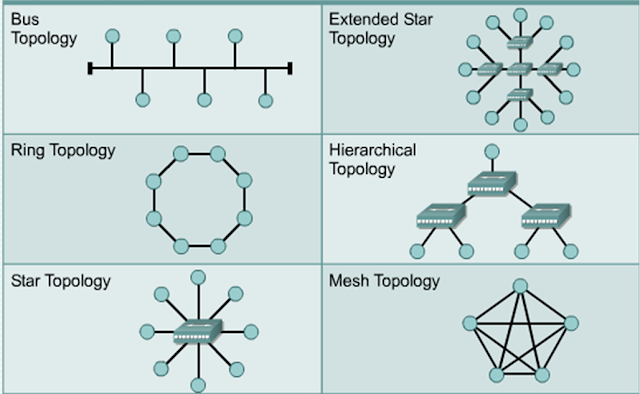
//

//

//
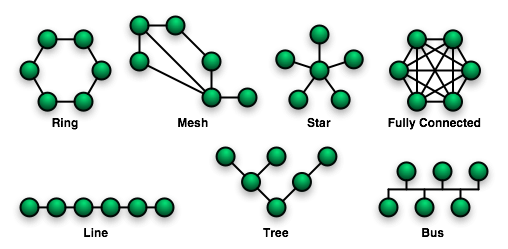
//

//

Expanded Star Topology
//

//
Bus Network Topology Diagram

//

Ring Topology
//
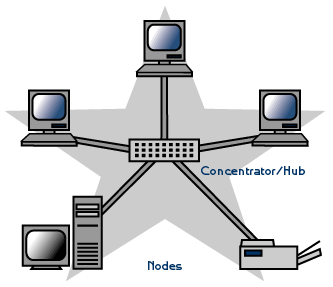
Star Network
//
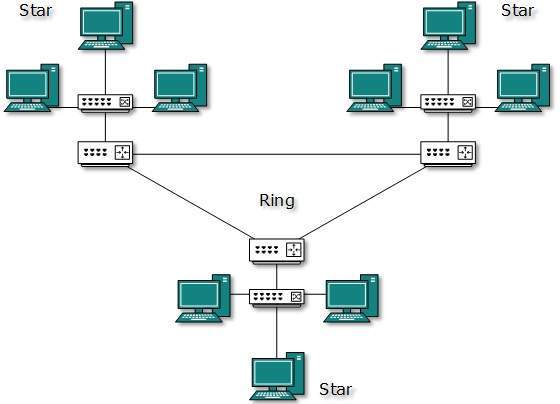
Hybrid
//

Mesh
//

//

//

//

//

//
Tree Network
//

//
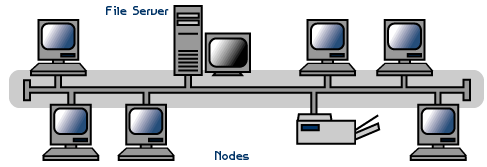
Fig. 1. Linear Bus topology
Advantages of a Linear Bus Topology
- Easy to connect a computer or peripheral to a linear bus.
- Requires less cable length than a star topology.
//
There are seven basic topologies:[4]
- Point-to-point topology
- Bus (point) topology
- Star topology
- Ring topology
- Tree topology
- Mesh topology
- Hybrid topology
Considerations When Choosing a Topology
- Money. A linear bus network may be the least expensive way to install a network; you do not have to purchase concentrators.
- Length of cable needed. The linear bus network uses shorter lengths of cable.
- Future growth. With a star topology, expanding a network is easily done by adding another concentrator.
- Cable type. The most common cable in schools is unshielded twisted pair, which is most often used with star topologies.
A network topology is how computers, printers, and other devices are connected over a network. It describes the layout of wires, devices, and routing paths. Essentially there are six different common topologies you should familiarize yourself with: Bus, Ring, Star, Extended Star, Hierarchical, and Mesh.
Although it is usually easier to start connecting wires and setting up your network, you’ll appreciate the level of organization these models provide- especially when your network grows in size. And if you’re looking to do well on networking exams, consider these topologies essential to both learn and memorize.
Bus Topology
The bus topology was fairly popular in the early years of networking. It’s easy to setup- not to mention inexpensive. All devices on the Bus Topology are connected using a single cable. If you need help remembering how the Bus Topology operates, think of it as the route a bus takes throughout a city.
It is extremely important to note that both ends of the main cable need to be terminated. If there is no terminator, the signal will bounce back when it reaches the end. The result: a bunch of collisions and noise that will disrupt the entire network.
The Bus Topology is less common these days. In fact, this topology is commonly used to network computers via coaxial cable- when’s the last time you can say you’ve done that?
It is extremely important to note that both ends of the main cable need to be terminated. If there is no terminator, the signal will bounce back when it reaches the end. The result: a bunch of collisions and noise that will disrupt the entire network.
The Bus Topology is less common these days. In fact, this topology is commonly used to network computers via coaxial cable- when’s the last time you can say you’ve done that?
Ring Topology
The Ring Topology is a very interesting topology indeed. It is a lot more complex that it may seem- it looks like just a bunch of computers connected in a circle! But behind the scenes, the Ring Topology is providing a collision-free and redundant networking environment.
Note that since there is no end on a Ring Topology, no terminators are necessary. A frame travels along the circle, stopping at each node. If that node wants to transmit data, it adds destination address and data information to the frame. The frame then travels around the ring, searching for the destination node. When it’s found, the data is taken out of the frame and the cycle continues.
But wait- it gets better! We have two types of Ring Topologies in networking: the one we just reviewed, and Dual-Ring Topology. In a Dual-Ring Topology, we use two rings instead of one. This creates a sense of redundancy so that if any point in the network fails, the second ring will (hopefully) be able to pick up the slack. If both rings were to fail at separate locations, we can even use the opposite ring at each point to “patch” the downed node.
Note that since there is no end on a Ring Topology, no terminators are necessary. A frame travels along the circle, stopping at each node. If that node wants to transmit data, it adds destination address and data information to the frame. The frame then travels around the ring, searching for the destination node. When it’s found, the data is taken out of the frame and the cycle continues.
But wait- it gets better! We have two types of Ring Topologies in networking: the one we just reviewed, and Dual-Ring Topology. In a Dual-Ring Topology, we use two rings instead of one. This creates a sense of redundancy so that if any point in the network fails, the second ring will (hopefully) be able to pick up the slack. If both rings were to fail at separate locations, we can even use the opposite ring at each point to “patch” the downed node.
In the above diagram, you can see that although the outer ring and inner ring failed at separate parts of the network. Thanks to redundancy, the network is still fully operational. This is generally more expensive to implement than other topologies- so it isn’t as common as the Star or Extended Star Topology.
Star / Extended Star Topology
One of the most popular topologies for Ethernet LANs is the star and extended star topology. It is easy to setup, it’s relatively cheap, and it creates more redundancy than the Bus Topology.
The Star Topology works by connecting each node to a central device. This central connection allows us to have a fully functioning network even when other devices fail. The only real threat to this topology is that if the central device goes down, so does the entire network.
The Star Topology works by connecting each node to a central device. This central connection allows us to have a fully functioning network even when other devices fail. The only real threat to this topology is that if the central device goes down, so does the entire network.
The Extended Star Topology is a bit more advanced. Instead of connecting all devices to a central unit, we have sub-central devices added to the mix. This allows more functionality for organization and subnetting- yet also creates more points of failure. In many cases it is impractical to use a Star Topology since networks can span an entire building. In this case, the Extended Star Topology is all but necessary to prevent degraded signals.
Whereas the Star Topology is better suited for small networks, the Extended Star Topology is generally better for the larger ones.
Whereas the Star Topology is better suited for small networks, the Extended Star Topology is generally better for the larger ones.
Hierarchical Topology
The Hierarchical Topology is much like the Star Topology, except that it doesn’t use a central node. Although Cisco prefers to call this Hierarchical, you may see it as instead referred to as the Tree Topology.
This type of topology suffers from the same centralization flaw as the Star Topology. If the device that is on top of the chain fails, consider the entire network down. Obviously this is impractical and not used a great deal in real applications.
This type of topology suffers from the same centralization flaw as the Star Topology. If the device that is on top of the chain fails, consider the entire network down. Obviously this is impractical and not used a great deal in real applications.
Mesh Topology
If you haven’t noticed, we’ve had a little problem with a fully redundant network. The Dual-Ring Topology helped, but it wasn’t perfect. If you are looking for a truly redundant network, look no further than the Mesh Topology. You will see two main types of Mesh Topology: Full-Mesh and Partial-Mesh.
The Full-Mesh Topology connects every single node together. This will create the most redundant and reliable network around- especially for large networks. If any link fails, we (should) always have another link to send data through. So why don’t we use it more often? Simple: how many wires would it take to link a computer to every device on a network of over 100 devices? Now multiply that for every device on the network- not a pleasant number is it? Obviously you should only use this in smaller networks. Alternatively, you could try a Partial-Mesh Topology.
The Full-Mesh Topology connects every single node together. This will create the most redundant and reliable network around- especially for large networks. If any link fails, we (should) always have another link to send data through. So why don’t we use it more often? Simple: how many wires would it take to link a computer to every device on a network of over 100 devices? Now multiply that for every device on the network- not a pleasant number is it? Obviously you should only use this in smaller networks. Alternatively, you could try a Partial-Mesh Topology.
The Partial-Mesh Topology is much like the full-mesh, only we don’t connect each device to every other device on the network. Instead we only implement a few alternate routes. After all- what are the odds a network will fail in multiple times near the same device?
You’ll see the Partial-Mesh Topology in backbone environments, since these are often vital networks that depend on redundancy to keep services running (such as an Internet Service Provider). Full-Mesh Topology is commonly seen in WANs between routers, yet also on smaller networks that depend on a redundant connection.
You’ll see the Partial-Mesh Topology in backbone environments, since these are often vital networks that depend on redundancy to keep services running (such as an Internet Service Provider). Full-Mesh Topology is commonly seen in WANs between routers, yet also on smaller networks that depend on a redundant connection.
Closing Comments
Keep in mind that network topology isn’t limited to the above examples. There are hybrids and variations of the topologies mentioned above.
Oddly enough, Cisco fails to categorize Point-to-Point Topology in their course material- but don’t worry, it’s just a simple connection between two endpoints. Perhaps it was considered too simple to include in the course material- either way, make sure you commit the above topologies to memory. You’ll be expected to know them when exam day comes- not to mention it could save you from a disorganized mess of a network!
Oddly enough, Cisco fails to categorize Point-to-Point Topology in their course material- but don’t worry, it’s just a simple connection between two endpoints. Perhaps it was considered too simple to include in the course material- either way, make sure you commit the above topologies to memory. You’ll be expected to know them when exam day comes- not to mention it could save you from a disorganized mess of a network!
/////////////////////////////////////////////////////
In the bus network topology, every workstation is connected to a main cable called the bus. Therefore, in effect, each workstation is directly connected to every other workstation in the network.
In the star network topology, there is a central computer or server to which all the workstations are directly connected. Every workstation is indirectly connected to every other through the central computer.
In the ring network topology, the workstations are connected in a closed loop configuration. Adjacent pairs of workstations are directly connected. Other pairs of workstations are indirectly connected, the data passing through one or more intermediate nodes.
If a Token Ring protocol is used in a star or ring topology, the signal travels in only one direction, carried by a so-called token from node to node.
The mesh network topology employs either of two schemes, called full mesh and partial mesh. In the full mesh topology, each workstation is connected directly to each of the others. In the partial mesh topology, some workstations are connected to all the others, and some are connected only to those other nodes with which they exchange the most data.
The tree network topology uses two or more star networks connected together. The central computers of the star networks are connected to a main bus. Thus, a tree network is a bus network of star networks.
Logical (or signal) topology refers to the nature of the paths the signals follow from node to node. In many instances, the logical topology is the same as the physical topology. But this is not always the case. For example, some networks are physically laid out in a star configuration, but they operate logically as bus or ring networks.
//
http://www.comptechdoc.org/independent/networking/guide/nethardware.html
http://www.webopedia.com/quick_ref/topologies.asp
http://compnetworking.about.com/od/networkdesign/ig/Computer-Network-Topologies/
//
In the star network topology, there is a central computer or server to which all the workstations are directly connected. Every workstation is indirectly connected to every other through the central computer.
In the ring network topology, the workstations are connected in a closed loop configuration. Adjacent pairs of workstations are directly connected. Other pairs of workstations are indirectly connected, the data passing through one or more intermediate nodes.
If a Token Ring protocol is used in a star or ring topology, the signal travels in only one direction, carried by a so-called token from node to node.
The mesh network topology employs either of two schemes, called full mesh and partial mesh. In the full mesh topology, each workstation is connected directly to each of the others. In the partial mesh topology, some workstations are connected to all the others, and some are connected only to those other nodes with which they exchange the most data.
The tree network topology uses two or more star networks connected together. The central computers of the star networks are connected to a main bus. Thus, a tree network is a bus network of star networks.
Logical (or signal) topology refers to the nature of the paths the signals follow from node to node. In many instances, the logical topology is the same as the physical topology. But this is not always the case. For example, some networks are physically laid out in a star configuration, but they operate logically as bus or ring networks.
//
http://www.comptechdoc.org/independent/networking/guide/nethardware.html
http://www.webopedia.com/quick_ref/topologies.asp
http://compnetworking.about.com/od/networkdesign/ig/Computer-Network-Topologies/
//

No comments:
Post a Comment